Matted Flax-lily
Matted Flax-lilyDianella amoena | |
|---|---|
| Kingdom: | Plantae |
| Phylum: | Magnoliophyta (Angiosperm) |
| Class: | Liliopsida (Monocotyledon) |
| Order: | Liliales |
| Family: | Phormiaceae |
| Status | |
| Australia: | Endangered (EPBC Act) |
| Victoria: | Critically Endangered (FFG Threatened List 2024) |
| Tasmania: | Rare |
| Vic FFG: | Listed |
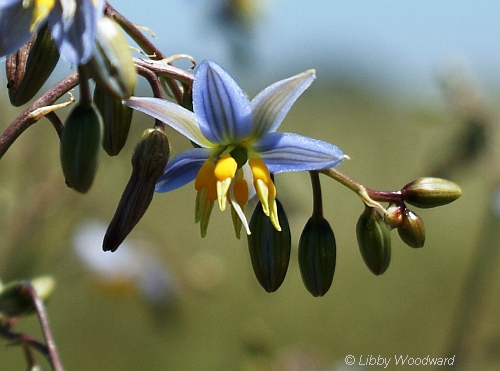
Matted Flax-lily Dianella amoena is a native grassland species which is considered endemic to Victoria with some doubt over recognition of this species from previous records in Tasmania (Carter 2010).
Matted Flax-lily is a perennial lily which forms clumps up to 5 m wide from rhizomes. Leaves are grey-green, dull crimson at the base, narrow and tapering, to 45 cm long by 12 mm wide. Flowering occurs from October to April, stems are 20-90 cm long and bear several bluish star shaped flowers. The fruit comprises numerous purple oval shaped berries.
Distribution
There are estimated to be only about 1,400 plants remaining in about 120 locations (Carter 2010).
Like many other species in our landscape, the habitat of Matted Flax-lily has become compromised. Land clearing and fragmentation of natural remnants has had a significant impact on this species. Grazing pressure from both introduced herbivores such as sheep and rabbits and native animals like Kangaroos have had a serious impact.
The destruction of sites for urban development has meant that today most natural Matted Flax-lily sites are restricted to roadsides, rail reserves, small conservation reserves, and cemetery reserves containing native grasslands. It is also found on a limited number of private land sites. It is still found in pockets of remnant native grasslands in Melbourne with several sites within the urban areas of Hume City, Darebin City and Banyule City Council.
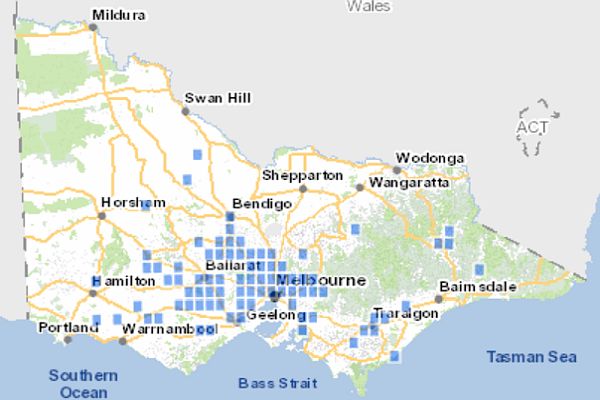
Source: Victorian Biodiversity Atlas 2024. Department of Energy, Environment and Climate Action - Victoria.
Threats
Threats to Matted Flax-lily are similar to that which apply to other grassland species;
- Invasion by environmental weeds.
- Excessive grazing.
- Accumulation of biomass through inadequate burning regime.
- Mechanical disturbance by machinery.
- Land use change and urbanisation around Melbourne's outer northern suburbs.
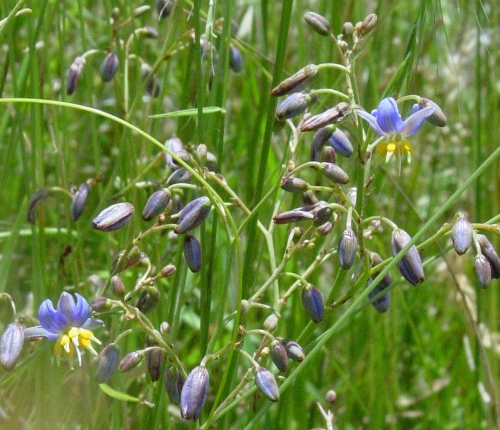
Conservation & Management
The conservation status of Matted Flax-lily was re-assessed from Endangered in 2013 (DSE 2013) to Critically Endangered in 2020 as part of the Conservation Status Assessment Project – Victoria (DELWP 2020).
There are about 50 sites in Victoria where some level of population monitoring and management occurs, mainly through the Department of Environment, Land, Water & Planning biodiversity officers, also in conjunction with Local Government, Committees of Management, local conservation groups, V/Line and VicRoads. At several sites known populations have received translocated plants salvaged from development sites, these are plants which have often been divided up from rhizomes or plants propagated from seed.
Note: in some cases locations below are kept general to maintain security of the site. As with many species of threatened flora excessive disturbance and trampling can be detrimental.
Conservation of Matted Flax-lily in the Melbourne area
Banyule City
- Browns Creek Nature Reserve - managed by Parks Victoria.
- Simpson Barracks (Watsonia Army Barracks) - managed by Department of Defence, management of area to include protection of Flax-lily plants.
Casey City
- Rail Reserve at Clyde - managed by V/Line in conjunction with DELWP, including ecological burning and weed control.
Darebin City
- Central Creek Grassland - this site is managed by the Merri Creek Management Committee. Approx 50 plants in situ with approx 300 plants to be planted out in translocation from Craigieburn Bypass freeway project.
- Cherry St Grasslands in is a particularly important site which is regularly monitored.
- Gresswell Forest Nature Conservation Reserve has active management of plants.
- Larundel Grassy Woodland Reserve is managed by VicUrban, with approximately 60 plants planted.
Hume City
- Craigieburn Grassland Nature Conservation Reserve - translocation of over 1400 plants from Craigieburn Bypass to supplement low numbers of wild plants within reserve.
- Ford rail reserve grassy woodland - managed by Australian Rail Track Corporation.
- Cooper Street Grassland Nature Conservation Reserve in the Somerton area of Melbourne; 400 plants planted by translocating from freeway works.
Manningham City
- Eltham Lower Park / Candlebark Park - active conservation of plants by Manningham City, weed control by Parks Victoria.
Moreland City
- Jukes Road Grassland - managed by Merri Creek Management Committee had approximately 200 plants translocated from the Craigieburn Bypass freeway project.
Nillumbik Shire
- St Andrews Flora Reserve - managed by Parks Victoria, regular weed control to protect known plants.
Whittlesea City Council
- Epping Cemetery - site managed by Whittlesea Council including weed control and monitoring.
- South Morang Flora and Fauna Reserve - part of the Mill Park Lakes Estate Development where plants were salvaged and placed in reserve.
- Merri Creek Parklands - Parks Victoria, plants managed by the Merri Creek Management Committee.
- Yan Yean Reservoir and Plantations - managed by Melbourne Water developing management strategy for conservation of plants.
Conservation of Matted Flax-lily in the Gippsland area
East Gipsland Shire
- Stratford Wildlife Reserve - managed by Trust for Nature, ecological burning, weed control, translocation into site.
Latrobe City
- Flynns Creek Road Rail Reserve - managed by V/Line, control of exotic grasses undertaken to protect plants.
- Eric Lubcke Yarra Gum Conservation Reserve - ecological burning and re-establishment of plants managed by shire.
- Mc Farlanes Road reserve -weed control and management of plants by shire.
- Traralgon to Rosedale rail line and adjacent road reserve on Princes Highway - V/Line are responsible for management and protection of some important populations along sections of this line and Sheepwash Creek area. VicRoads responsible for plants on road reserve area.
- Traralgon area rail reserves - managed by V/Line in conjunction with DELWP, weed control and survey health of plants.
Wellington Shire
- Darriman Reserve - managed by Parks Victoria. Dianella amoena was introduced to this reserve in August 2010.
- Dawson Native Plant Reserve - approximately 112 Dianella amoena tube stock were planted at Dawson FR in May 2015.
- Munro, road reserve area managed by shire to restore Central Gippsland Plains Grassland vegetation including protection of Flax-lily plants.
- Stratford area - road reserve - site managed by shire including on-going weed control to protect plants, health of plants monitored by DELWP.
- Stratford Woodland Reserve - some planting from propagated seed has been carried out by Trust for Nature.
- Middle Creek Rail Reserve - managed by V/Line in conjunction with DELWP, weed control and survey health of plants and prevent public access.
Conservation of Matted Flax-lily in Central Victoria
Macedon Ranges Shire
- Bald Hill Reserve Kyneton - surveys and weed control.
- Riddells Creek Rail Reserves - plants managed in partnership between V/Line, VicRoads, Shire and DELWP.
- Riddells Creek - Sutherland Road area managed by V/Line for weed control, survey for plants by DELWP.
Mount Alexander Shire
- Castlemaine Botanic Gardens Rail Reserve - managed in conjunction with VLine.
- Castlemaine Cemetery - Castlemaine Cemetery Trust, Friends of Campbells Creek and Mount Alexander Shire Council
- Harcourt Rail Reserve - managed by V-Line
- Pethybridge Road Rail Reserve - site managed by V-Line, monitoring conducted by DELWP.
Hepburn Shire
- Werona area - survey and monitoring.
Private land
- A Matted Flax-lily replanting project was funded via the Trust for Nature's Land Management Innovation Fund during 2011 to 2013.
- 650 Matted Flax-lily Dianella amoena plants were grown and were planted autumn 2012. These plants come from the North Central area and were planted back in the North Central Trust for Nature area. Nine landholders were keen to be involved and they each planted (with some help from Trust for Nature staff) between 50 and 100 plants on their property.
- In 2013 it was decided that landholders would add plants to the areas where they had grown best. Survival rates were very high with most landholders only having a few plants die. Another 250 plants were added to the areas which showed the greatest success.
- In autumn 2013, an additional 100 Matted Flax-lily plants were planted on the 9 grassland properties. Contact for Central Vic. Trust for Nature Project: Libby Woodward, Trust for Nature.
Research
Chromosomal assessment and population genomics to inform conservation of the endangered Matted Flax-lily (Dianella amoena)
A Masters project undertaken by Tamandra D'Ombrain, La Trobe University, Bundoora, Australia, to improve information about genomic structuring of remnant populations of Matted Flax-lily Dianella amoena commenced in February 2020.
The project used traditional and contemporary genomic approaches to better inform conservation efforts of Dianella amoena. Within the Dianella genus some species are known to have multiple chromosome races, but chromosome numbers in Dianella amoena have not been assessed.
Both polyploidy and intraspecific ploidy variation was found to be present in and among D. amoena populations. The project also used SNP data from DArTseq to investigate clonality within and genomic structuring among populations with a focus on Victorian populations. The overall aim was to inform species managers of any genomic structuring of remnant D. amoena populations and thereby be of assistance in designing translocation programs that seek to optimise diversity while also maintaining natural structuring.
Principal supervisor - Susan Hoebee. Key collaborators - Michael Cincotta, Nicholas Murphy & Steve Sinclair.
D’Ombrain, T. (2022). Chromosomal assessment and population genomics to inform conservation of the endangered Matted Flax-lily (Dianella amoena). Masters Thesis (in review). La Trobe University, Bundoora, Australia.
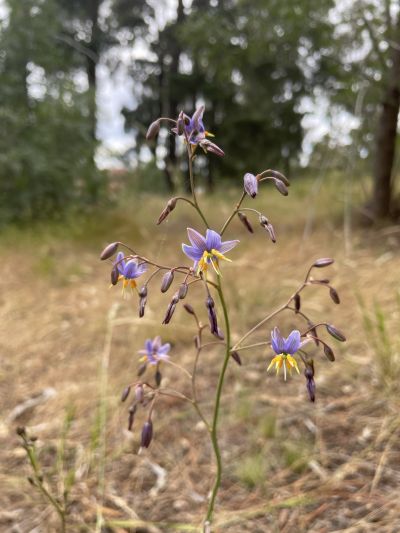
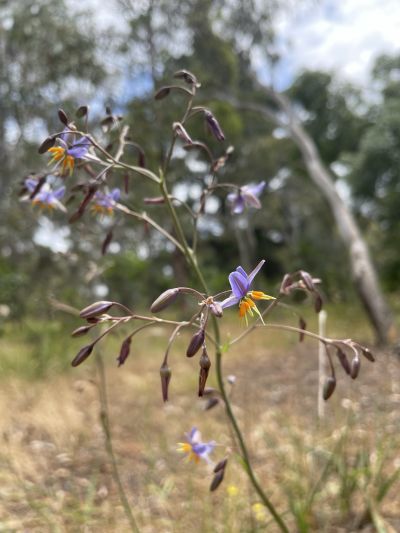
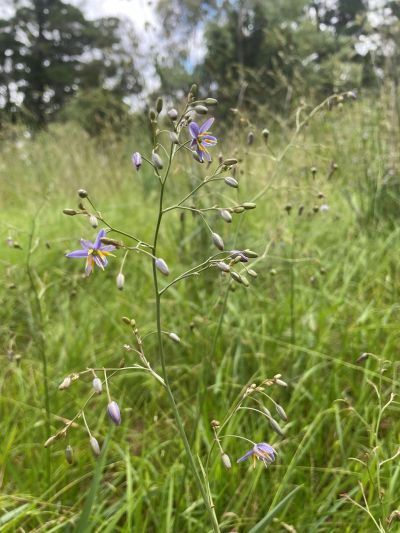
Above: Images taken at Bundoora1-3: Inflorescences captured in December on the La Trobe University Bundoora campus. Images: Tamandra D’Ombrain
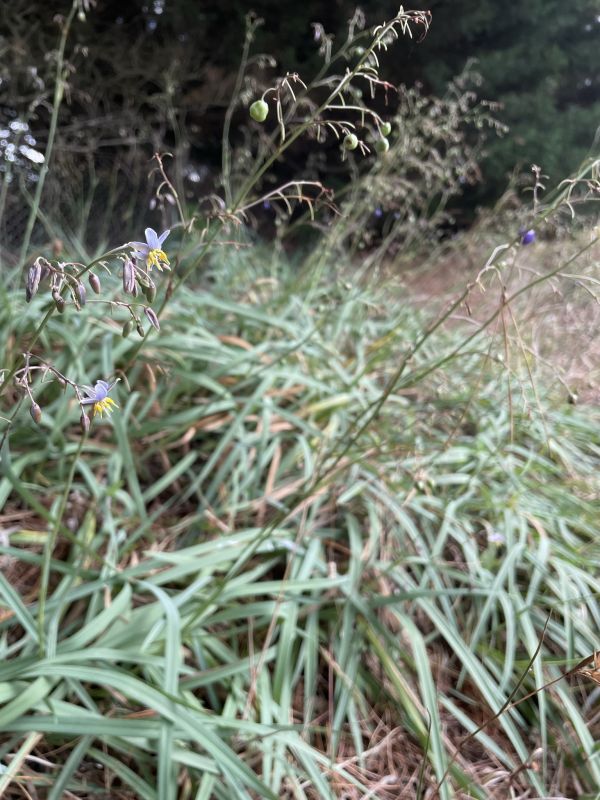
References & Links
- DEECA (2024) Flora and Fauna Guarantee Act 1988 - Threatened List - June 2024 Department of Energy, Environment and Climate Action - Victoria.
- DELWP (2020) Provisional re-assessments of taxa as part of the Conservation Status Assessment Project – Victoria 2020, Department of Environment Land Water and Planning, Victoria. Conservation Status Assessment Project – Victoria
- DSE (2013) Advisory List of Rare or Threatened Plants in Victoria
- National Recovery Plan for the Matted Flax-lily Dianella amoena. Carter, O. (2010). Department of Sustainability and Environment, Victoria.
- Australian Government, Threats Profile and Species Database
- Threatened vascular plants list for Tasmania

